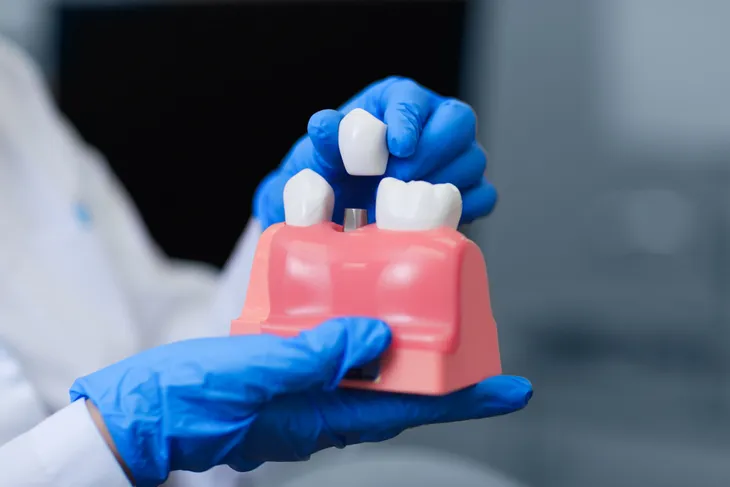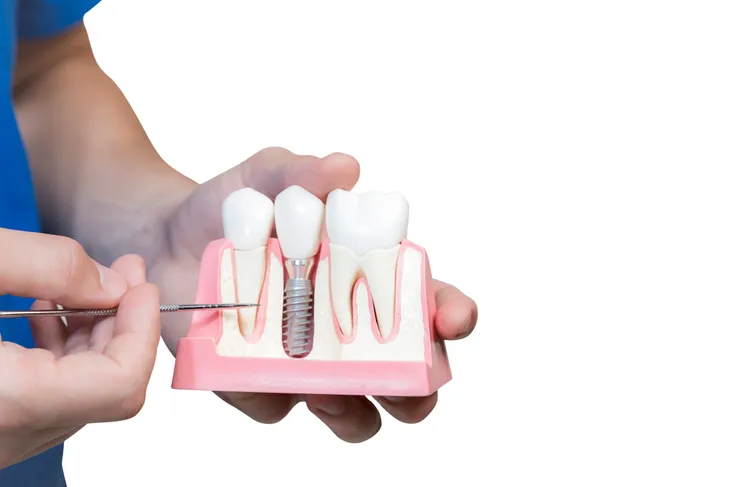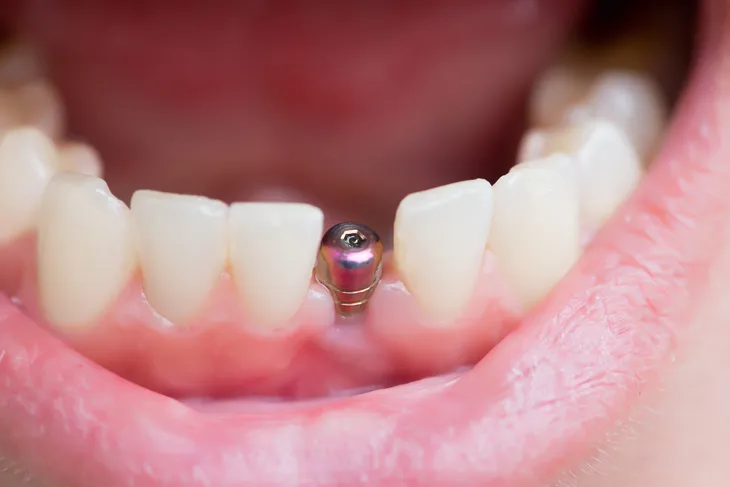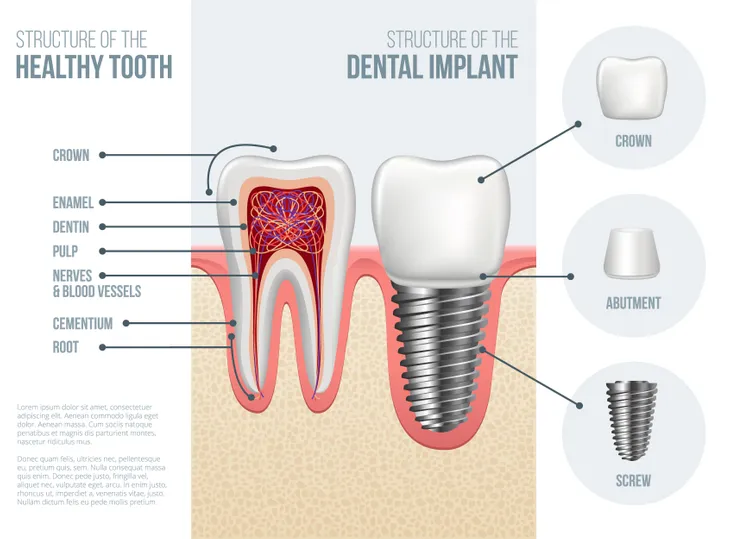Even though most of us have access to extremely good dental care, there are still millions of Americans who suffer from tooth loss. According to WebMD, the most common causes of tooth loss are tooth decay, periodontal disease, or injury. For a long time the only way to treat tooth loss was with bridges and dentures, but now there is another option — dental implant surgery.
Let’s take a look at everything a person might want to know and should expect ahead of this procedure…
1. What are Dental Implants?
Dental implants are used to replace tooth roots. Thus, dental implant surgery is a procedure that uses metal, screw-like posts to replace old, damaged, or missing teeth with new artificial teeth that look surprisingly real, and can function exactly like real teeth. It’s pretty impressive! “Implants provide a strong foundation for fixed (permanent) or removable replacement teeth that are made to match your natural teeth,” writes WebMD.
This surgery is a great alternative to dentures or bridgework, particularly for people who do not have natural teeth roots or those who don’t have the groundwork to allow the construction of dentures or bridgework. The Mayo Clinic goes on to explain that how dental implant surgery is performed depends on the type of implant and the condition of the jawbone.
2. Who Qualifies for Dental Implants?
As we already mentioned, people get dental implants to replace teeth roots. They are surgically placed into the jawbone and fused to the bone which means they won’t slip, make noise, or damage the bones or any already existing teeth the way that bridgework or dentures could. However, there are some stipulations for who can qualify to get the surgery done. You have to have healthy oral tissue, don’t smoke tobacco, one or more missing teeth, a jawbone that has reached full growth, adequate bone structure to secure the implants or able to have a bone graft. You must also not have any conditions that would interfere or affect bone healing, be unable or unwilling to wear dentures and be able to commit to several moths of the procedure, says the Mayo Clinic.
3. What are the Risks?
The success rate of dental implant surgery is extremely high, it sits somewhere around 98-percent, says WebMD. This rate is based on where in the jaw the implants are placed. Since it is a surgery, there are some risks involved, which is the case with any and all surgeries. The Mayo Clinic assures that these risks are quite rare and when they do occur they are minor and treatable. The most common risks are: “an infection at the site of the implant, injury or damage to surrounding structures, such as other teeth or blood vessels, nerve damage.” This can result in pain, numbness, or tingling in the existing natural teeth, as well as the gums, lips or chin. Also, the surgery could cause some problems with the sinus “when dental implants placed in the upper jaw protrude into one of your sinus cavities,” says the Mayo Clinic.
4. What are the Advantages?
There are many advantages that come from having dental implant surgery. WebMD outlines them all in detail — some of these advantages include improved appearance because dental implants look and feel like real teeth. Since they are designed to fuse with the bone, they are also permanent. They can improve speech and comfort. “With poor-fitting dentures, the teeth can slip within the mouth causing you to mumble or slur your words,” writes the source. “Dental implants allow you to speak without worry that teeth might slip.” Their permanence also makes it easier to eat than it is with dentures which can easily slip while chewing. All of these things will also improve self esteem because a person with implants doesn’t have to worry or be self conscious about their teeth.
In addition to all this, implants can improve oral health since they don’t require a dentist to tinker with the already existing teeth to create a supporting bridge. “Because nearby teeth are not altered to support the implant, more of your own teeth are left intact, improving long term oral health,” writes WebMD. “Individuals implants also allow easier access between teeth, improving oral hygiene.” As we already mentioned, implants are also extremely durable and can last many, many years. If they are taken care of properly, they could even last a lifetime, says the source.
Lastly, implants are permanent and not removable which means a patient doesn’t have to worry about the embarrassment of removing their dentures or using adhesives to keep them in place.
5. The Beginning Stages…
Since there are several procedures that go into dental implant surgery, there will be a variety of different specialists working on a patient. The Mayo Clinic points out that there will be a doctor who specializes in the mouth, jaw, and face (also know as a maxillofacial surgeon), “a dentist specializing in treating structures that support the teeth, such as gums and bones (periodontist), a dentist who designs and fits artificial teeth (prosthodontist), or occasionally an ear, nose and throat (ENT) specialist,” writes the source.
You will first have to go through a dental exam where x-rays and 3D images will be taken. They will also make a model of your teeth and jaw. After that, your medical history will be reviewed. This is the time when any medications or medical conditions will be taken note of, including over-the-counter drugs and supplements. Someone who has a heart condition or orthopedic implants might be prescribed antibiotics prior to the surgery to prevent infection, says the Mayo Clinic.
Lastly, they will devise a treatment plan that is specifically tailored to what work you need to have done which takes into account “factors such as how many teeth you need replaced and the condition of your jawbone and remaining teeth.”
6. Is it Painful?
According to most people who have been through the procedure, the pain is quite minimal. WebMD explains that the patient is given a local anesthesia during the procedure which means they don’t feel much pain. In fact, it’s less painful than a tooth extraction.
Of course, after the surgery there might be some mild discomfort, but this can be easily treated with over-the-counter pain medication like Tylenol or Motrin.
7. How Long Does it Take?
The procedure itself is performed in several different stages to allow for healing time between procedures. In order to place a dental implant the following steps must be taken, “damaged tooth removal, jawbone preparation (grafting), when needed, dental implant placement, bone growth and healing, abutment placement,” and lastly artificial tooth placement. Because there are many different stages that require healing time in between, the entire process can take several months from start to finish, says the Mayo Clinic.
Very Well Health explains that the exact length varies depending on each patient and their specific dental health, number of teeth involved, which teeth are replaced, and if a tooth needs to be extracted beforehand. The source goes on to state that these factors also determine how many doctor visits a patient will need and how long each appointment will be. “For instance, a single tooth implant surgery can typically take one to two hours from start to finish. This includes time for anesthesia as well as dressing the patient for a sterile surgical environment,” writes the source.
8. Bone Grafting Might be Needed
Bone grafting is only needed in some cases and it all depends on the structure of the jawbone. When it is needed, it’s due to the fact that you may need some extra bone to give the implant a more solid foundation, says Colgate. But the Mayo Clinic adds that it could also be due to the fact that your jawbone is too soft. Chewing can be such a powerful action that exerts a lot of pressure, and if the foundation isn’t solid enough, the implantation process won’t hold up in the long run.
Bone grafting is “a procedure in which a small bit of bone is transplanted to help solidify the implant base within the jawbone. This bone transplant typically comes from another area in the upper or lower jawbone away from the dental implant area, but it could also potentially come from another part of the body,” writes Colgate. A bone graft can also be created out of synthetic material like a bone-substitute “that can provide support structures for new bone growth,” says the Mayo Clinic.
This part of the process might take several months in order for transplanted bone to grow enough that it can support an implant. If a patient only needs some minor grafting, it can probably take place at the same time as the implant surgery.
9. First Step: Place the Implant
This will only be the first step if not bone grafting was required, but either way, one of the first steps is to place the dental implant. This stage requires the surgeon to cut a hole in the gums and expose the bone in order to fuse the implant on. “Holes are drilled into the bone where the dental implant metal post will be placed,” writes the Mayo Clinic. “Since the post will serve as the tooth root, it’s implanted deep into the bone.”
After the procedure is finished, there will still be a gap in your teeth where the original tooth is missing. If this bothers you, they can place a partial temporary denture there which can be removed for cleaning and while you sleep.
10. Second Step: Wait for Bone Growth
After the metal implant post is installed into the jawline, they must wait for bone growth, which is also referred to as osseointegration (oss-ee-oh-in-tuh-GRAY-shun). “During this process, the jawbone grows into and unites with the surface of the dental implant,” writes the Mayo Clinic. Unlike some of the other steps, this process can take several months. Although it’s time consuming, it “helps provide a solid base for your new artificial tooth — just as roots do for your natural teeth.”
11. Third Step: Place the Abutment
The next step is to have another surgery to place the abutment. The abutment where the crown will be attached. The Mayo Clinic notes that it is a minor surgery and usually performed with local anesthesia in an outpatient setting. “The abutment can be attached to the implant during the initial implantation phase, but many people don’t care for the visibility of the post and thus elect for a second procedure to install it later,” explains Colgate. However, if someone chooses to do this, then it will eliminate an extra surgical step.
For those who do go through with this step, the Mayo Clinic lists three steps that have to be taken in order to place the abutment — first, the oral surgeon will open your gums and expose the dental implant. The abutment is then attached and the gum tissue around is closed, but not over top. Once the abutment is placed, it takes about two weeks to heal before an artificial tooth can be attached.
12. Fourth Step: Choosing Artificial Teeth
Once the gums have healed, you’ll need impressions made which are what will give you a beautiful pearly white smile! “These impressions are used to make the crown — your realistic-looking artificial tooth,” explains the Mayo Clinic. “The crown can’t be placed until your jawbone is strong enough to support use of the new tooth.”
You will have the option of choosing artificial teeth that are either removable or fixed. Removable artificial teeth are similar to dentures and can be a partial or full denture. “It contains artificial teeth surrounded by pink plastic gum. It’s mounted on a metal frame that’s attached to the impact abutment, and it snaps securely into place.” It can be removed for repair and cleaning. The other option is fixed which would be permanently screwed into the implant abutment. You will not be able to remove the tooth for cleaning or repair like the other option, and most of the time, the “crown is attached to its own dental implant.” These implants are extremely strong, so several teeth can be replaced with one implant as long as they are bridged together, says the Mayo Clinic.
13. After the Procedure
Whether the implant surgery took place in one session or over several different procedures, there will undoubtedly be a little bit of mild discomfort that comes along with the dental surgery. Afterwards, you might notice some swelling in gums and face, bruising on the side of your skin, pain at the implant site, and minor bleeding, says the Mayo Clinic.
You might be prescribed some medication to deal with the pain. The source notes that if any of the swelling or discomfort gets worse in the days following the surgery, then you should contact your oral surgeon. You may need to stick to soft foods while the implant site heals. When it comes to the stitching, the surgeon will most likely use stitches that dissolve on their own, but if they aren’t self-dissolving, a surgeon will need to remove them.
14. The Results
While the surgery has a high success rate — as we already mentioned it’s about 98-percent — there are times when things go wrong. Most commonly it has to do with the bone not fusing to the metal implant. This could happen if someone is a smoker which can cause the implant to fail or complications to arise. If the bone doesn’t fuse properly, the implant will be removed. The bone is then cleaned up, and they can try to procedure again.
To help maintain good results, the Mayo Clinic advises patients practice good oral hygiene. Keep the implants clean by using the specially designed brushes (interdental brush) that slide between the teeth and get into all those nooks and crannies in your mouth. You can also visit the dentist regularly to get checkups and professional cleanings. Lastly, avoid any damaging habits like smoking, chewing on hard candy, ice, or even drinking coffee, which can stain the teeth.

















